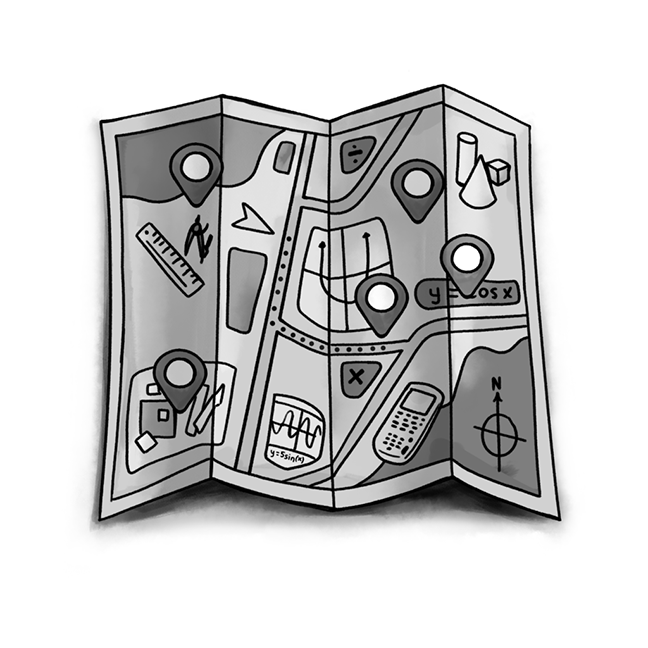Karen Wootton, Director of Curriculum and Assessment, karenwootton@cpm.org
Even with the best of teachers, there are times when some students just do not get it. Whether it is complicated mathematics or warm spring days hindering students’ progress, teachers need to be prepared for those times when some students struggle.
With the issue of how best to support students who sometimes struggle arising more and more in conversations, I set out to find out more about best practices for supporting students, and to figure out how CPM can enhance our materials to incorporate these best practices.
In the March newsletter, I shared the good news that according to the speakers and sessions at NCTM’s November Innov8 conference, CPM is already doing what is best for Tier 1 instruction. CPM provides the materials for a student-centered classroom where students work in teams, we present problems and situations that are low-floor/high-ceiling, teachers utilize Study Team and Teaching Strategies that support student discourse, and CPM teachers have lessons that support these classroom behaviors.
But sometimes even effective Tier 1 instruction is still not enough. In that case, what should the teacher do? Is it up to the student to come in at lunch or after school for more help? Where should the responsibility for learning fall – equally on the student and the teacher? What are the key teacher moves that will help the student?
While I have not found all the answers yet, I have made progress. One of the key issues is understanding the difference between reteaching and re-engagement. A teacher’s natural response to students not understanding a lesson, is to reteach it. “Maybe if I use different examples or give them more practice this time they will get it!” we might tell ourselves. “Maybe louder and slower?” However, this has not shown to be effective. Rather, teachers need to develop re-engagement lessons. A re-engagement lesson approaches a concept, topic, or skill from a different angle, allowing the student to approach the idea in a new light.
Here is a simple illustration of the difference between reteaching and re-engagement. Suppose a teacher is introducing negative numbers and has students using a number line for understanding and calculating. Not all students will have a complete understanding or have mastered addition of positive and negative numbers by the end of the class. The teacher should expect that the mixed, spaced practice will help, but if the teacher is aware that some students are not understanding (as opposed to being in the early stages of emerging understanding), the teacher must do something differently. The teacher might create a lesson, revisiting the number line, this time with new examples and problems to do. However, some students will not need this reteaching, and will become bored by this repetitive lesson. The students that need something will not benefit by looking at the math through the same lens; it will not change their understanding. But, if the teacher introduces a new approach it can benefit all students including those students who seem to have already mastered the topic. A re-engagement lesson could bring in integer tiles to present positive and negative numbers in a new light. With a re-engagement lesson, new questions and ideas arise. Using integer tiles changes the lens and so new opportunities for understanding emerge. At first, some students might not even realize that they are learning the same concept as they were with the number line. Some students might start making connections with the new approach that they did not make with the first approach. And even those that seemed to grasp positive and negative numbers with the number line are benefiting from now viewing the concept with the tiles. There is also an opportunity for students to connect the two different representations. Thus, a re-engagement lesson does not bore some students while helping others. Everyone benefits from the re-engagement lesson.
The Desmos lessons mentioned in an earlier article, are designed as re-engagement lessons. The lessons approach the concept from a different angle and also utilize the Desmos technology to give students another way of considering the math. These lessons are linked in the CPM Core Connections Course 3 eBook, but are also available to any CPM eBook user at teacher.desmos.com/cpm. These lessons will also be embedded in a support course CPM is writing for CC3. It is important for any support course to employ the necessary components of what students need, namely opportunities to discuss mathematics while working on rich team-worthy problems that have a low floor but high ceiling. Students in support courses should never be denied the same opportunities for rich mathematics that other students have.
Most CPM lessons have opportunities for re-engagement again and again throughout a course. You might notice that sometimes the course starts a topic or concept and then covers another topic for a few days before returning to the original idea. This allows for some development to happen through the Review & Preview. Some new pieces blend into the lessons setting the student up to make connections. Then when they see the topic again, students bring with them a different lens. Despite CPM’s intentional content design and mixed, spaced practice, there is always room for improvement, and the Desmos lessons are just one example of CPM continuing to work for More Math for More People.
